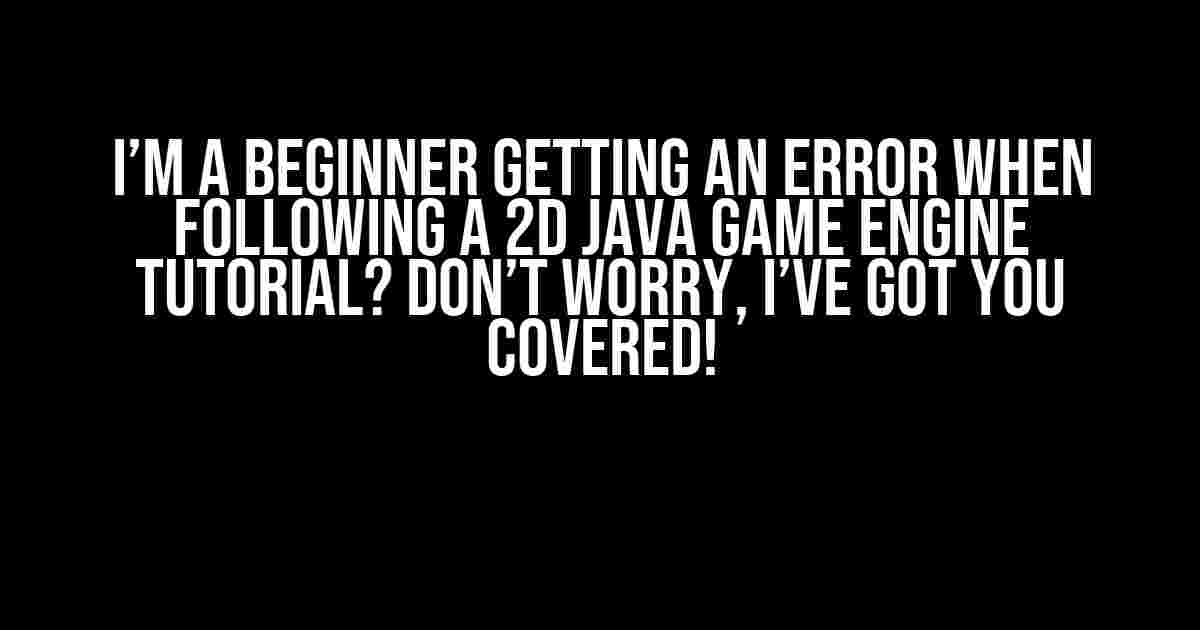Hey there, fellow coding enthusiast! Are you frustrated because you’re stuck on a 2D Java Game Engine tutorial and can’t seem to figure out why you’re getting an error? Well, take a deep breath and relax, because you’re in the right place! In this article, we’ll go through some common errors that beginners face when following a 2D Java Game Engine tutorial, and I’ll provide you with clear and direct instructions on how to fix them.
Common Error 1: Missing or Incorrect Java Version
One of the most common errors that beginners face is related to the Java version. If you’re using an outdated or incorrect version of Java, you’ll get errors left and right! So, let’s check if you have the correct version installed.
// Check your Java version in the command prompt or terminal
java -version
If you don’t have Java 8 or later installed, you can download it from the official Oracle website.
FIX: Update Your Java Version
Follow these steps to update your Java version:
- Download the latest version of Java from the official Oracle website.
- Install Java on your computer by following the installation instructions.
- Restart your computer to ensure the changes take effect.
- Open your command prompt or terminal and type
java -versionto verify that you have the correct version installed.
Common Error 2: Missing or Incorrect Libraries
Libraries are essential for building a 2D Java game engine. If you’re missing or have incorrect libraries, you’ll get errors that’ll drive you crazy! So, let’s take a look at how to fix this issue.
// Check if you have the correct libraries in your project
import java.awt.*;
import javax.swing.*;
import java.util.*;
If you’re using an IDE like Eclipse or IntelliJ IDEA, make sure you have the correct libraries imported in your project. If you’re using a command-line compiler, ensure that you have the correct jar files in your classpath.
FIX: Update Your Libraries
Follow these steps to update your libraries:
- If you’re using an IDE, check if you have the correct libraries imported in your project. You can do this by checking the project settings or by looking at the import statements at the top of your Java file.
- If you’re using a command-line compiler, ensure that you have the correct jar files in your classpath. You can do this by adding the jar files to your classpath or by using a build tool like Maven or Gradle.
- Verify that you have the correct libraries by checking the documentation of the 2D Java game engine tutorial you’re following.
Common Error 3: Incorrect Project Structure
A correct project structure is crucial when building a 2D Java game engine. If your project structure is incorrect, you’ll get errors that’ll make your head spin! So, let’s take a look at how to fix this issue.
// Example of a correct project structure
game-engine-project
+- src
+- main
+- java
+- com
+- example
+- Game.java
+- resources
+- images
+- background.png
+- sounds
+- music.wav
+- libs
+- lwjgl.jar
+- lwjgl_util.jar
A correct project structure should have the following folders:
src/main/java: This folder contains your Java source code.resources: This folder contains your game resources such as images and sounds.libs: This folder contains the libraries required for your project.
FIX: Update Your Project Structure
Follow these steps to update your project structure:
- Create a new folder for your project and name it accordingly (e.g.,
game-engine-project). - Create the following subfolders inside your project folder:
src/main/java,resources, andlibs. - Moved your Java source code to the
src/main/javafolder. - Moved your game resources to the
resourcesfolder. - Moved your libraries to the
libsfolder. - Update your project settings or build path to reflect the new project structure.
Common Error 4: Incorrect Code Syntax
Incorrect code syntax is another common error that beginners face when following a 2D Java game engine tutorial. If your code syntax is incorrect, you’ll get errors that’ll make you pull your hair out! So, let’s take a look at how to fix this issue.
// Example of incorrect code syntax
public clas Game {
public statis void main(String[] args) {
// Code here
}
}
The above code has several syntax errors. The correct code should be:
// Example of correct code syntax
public class Game {
public static void main(String[] args) {
// Code here
}
}
FIX: Update Your Code Syntax
Follow these steps to update your code syntax:
- Check your code line by line to ensure that the syntax is correct.
- Use an IDE like Eclipse or IntelliJ IDEA to help you catch syntax errors.
- If you’re using a command-line compiler, use the
-Xlintoption to enable syntax checking. - Verify that your code is correct by comparing it with the tutorial you’re following.
Common Error 5: Missing or Incorrect Dependencies
Missing or incorrect dependencies can cause errors that’ll make you want to give up on your 2D Java game engine project! So, let’s take a look at how to fix this issue.
// Example of a dependencies section in a Maven POM file
<dependencies>
<dependency>
<groupId>org.lwjgl</groupId>
<artifactId>lwjgl</artifactId>
<version>2.9.3</version>
</dependency>
<dependency>
<groupId>org.lwjgl</groupId>
<artifactId>lwjgl_util</artifactId>
<version>2.9.3</version>
</dependency>
</dependencies>
If you’re using a build tool like Maven or Gradle, ensure that you have the correct dependencies in your project file.
FIX: Update Your Dependencies
Follow these steps to update your dependencies:
- If you’re using a build tool like Maven or Gradle, verify that you have the correct dependencies in your project file.
- Check the documentation of the 2D Java game engine tutorial you’re following to ensure that you have the correct dependencies.
- Update your dependencies by adding or removing dependencies as required.
- Verify that your project compiles and runs correctly.
Conclusion
There you have it, folks! These are some common errors that beginners face when following a 2D Java game engine tutorial. By following the steps outlined in this article, you should be able to fix these errors and get back on track with your project. Remember, practice makes perfect, so don’t give up on your project! If you have any more questions or need further assistance, feel free to ask!
| Common Error | FIX |
|---|---|
| Missing or Incorrect Java Version | Update Your Java Version |
| Missing or Incorrect Libraries | Update Your Libraries |
| Incorrect Project Structure | Update Your Project Structure |
| Incorrect Code Syntax | Update Your Code Syntax |
| Missing or Incorrect Dependencies |


